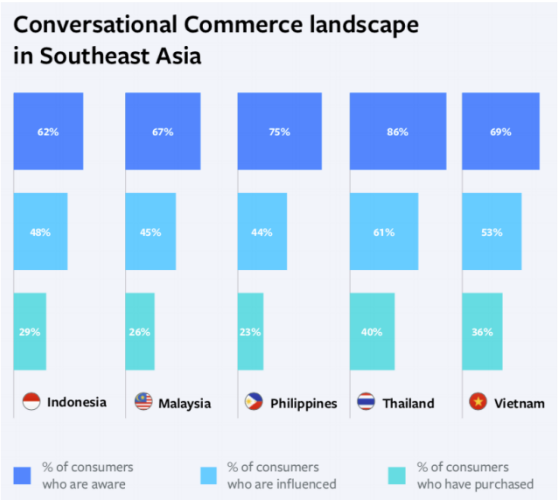Southeast Asia outpaces other surveyed countries — 72% to 49% respectively — in terms of awareness and adoption of conversational commerce, or the practice of using online chat or voice assistance with the intent to induce the acquisition of goods or services, according to a joint study conducted by Facebook and Boston Consulting Group.
This new commercial behavior is becoming mainstream across the world and gives brands the opportunity to engage potential buyers before and after-sale via online chat tools, whether is it over social messaging applications or over chatbox on e-commerce websites, says Facebook in its report.
High level of awareness and adoption
In terms of awareness, 72% of the respondents in Southeast Asia said they know about this form of online shopping method, as compared to the average 49% across other surveyed countries. Thailand and the Philippines are the two countries with the highest rate of awareness at 86% and 75% respectively.
All countries in Southeast Asia are also better placed when it comes to the adoption of conversational commerce, or c-commerce, compared to other surveyed countries such as United States (5%), Mexico (6%), India (10%), and Brazil (11%).
Thailand is still the most advanced country with over 40% of the respondents saying that they have undertaken a conversational commerce transaction, followed by Vietnam with 36%.

Social media as the point-of-entry
The joint study also finds that the primary point-of-entry to conversational commerce is social media. 69% of the respondents said they first found out about this method of shopping from either a social media post, link, or advertisement in their feed.
Close to half of the shoppers said they have bought or sold on social media or messaging platforms, while 44% said they use e-commerce platforms and only the remaining 9% use brand websites.

The most popular social media site in Southeast Asia for conversational commerce is Facebook. Nine out of 10 surveyed Indonesians said they use the Facebook family of apps to make a conversational commerce transaction.
Chat allows buyers to gain more production information
According to the report, the main reason for which consumers are inclined to conversational commerce is the ability to get more information (product information and pricing information) by chatting with the seller (57%). Shoppers also value the ability to negotiate with sellers on price and offers (35%), and to get instant responses from sellers (35%).

Conversational commerce on social media was already a common practice in countries like Indonesia before e-commerce platforms became popular. According to a McKinsey study released in 2018, this kind of “informal selling” generated up to USD 3 billion in the country in 2017.
This consumer behavior is becoming more popular amongst shoppers as “it combines the best of both worlds–the personalized advice they would get in a physical store with the sheer convenience and variety available to them on e-commerce retail channels,” according to Sarita Singh, director at Global Business Group for Southeast Asia & Emerging Countries at Facebook.
The joint study by Facebook and Boston Consulting Group surveyed over 8,000 people across Brazil, Indonesia, India, Mexico, the Philippines, United States, Vietnam, Thailand, and Malaysia, through qualitative interviews with buyers, sellers, and experts on the topic of conversational commerce. There were 5,391 respondents from Southeast Asia.
